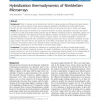Free Online Productivity Tools
i2Speak
i2Symbol
i2OCR
iTex2Img
iWeb2Print
iWeb2Shot
i2Type
iPdf2Split
iPdf2Merge
i2Bopomofo
i2Arabic
i2Style
i2Image
i2PDF
iLatex2Rtf
Sci2ools
BMCBI
2010
2010
Hybridization thermodynamics of NimbleGen Microarrays
Background: While microarrays are the predominant method for gene expression profiling, probe signal variation is still an area of active research. Probe signal is sequence dependent and affected by probe-target binding strength and the competing formation of probe-probe dimers and secondary structures in probes and targets. Results: We demonstrate the benefits of an improved model for microarray hybridization and assess the relative contributions of the probe-target binding strength and the different competing structures. Remarkably, specific and unspecific hybridization were apparently driven by different energetic contributions: For unspecific hybridization, the melting temperature Tm was the best predictor of signal variation. For specific hybridization, however, the effective interaction energy that fully considered competing structures was twice as powerful a predictor of probe signal variation. We show that this was largely due to the effects of secondary structures in the prob...
| Added | 08 Dec 2010 |
| Updated | 08 Dec 2010 |
| Type | Journal |
| Year | 2010 |
| Where | BMCBI |
| Authors | Ulrike Mückstein, Germán G. Leparc, Alexandra Posekany, Ivo L. Hofacker, David P. Kreil |
Comments (0)

